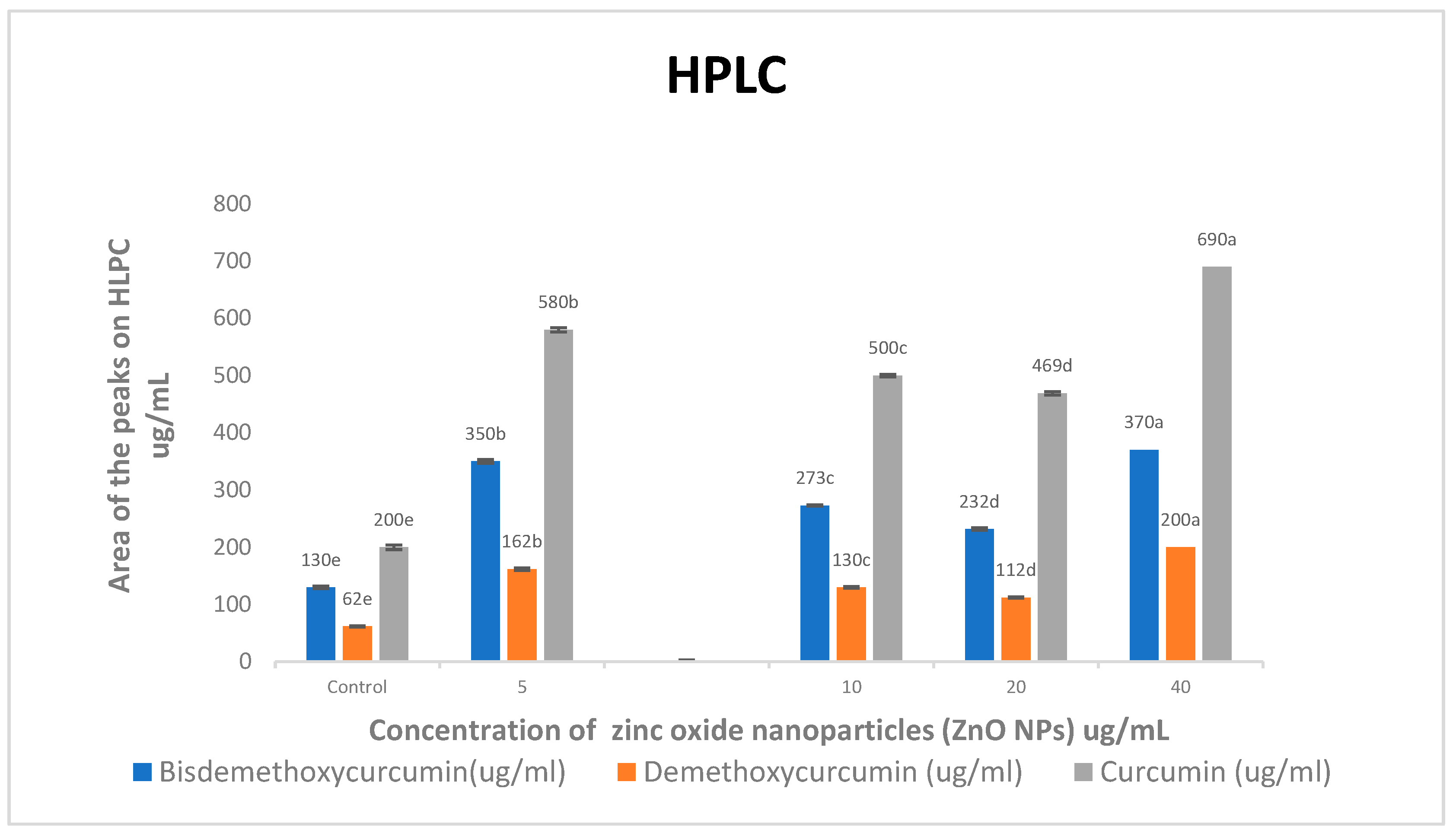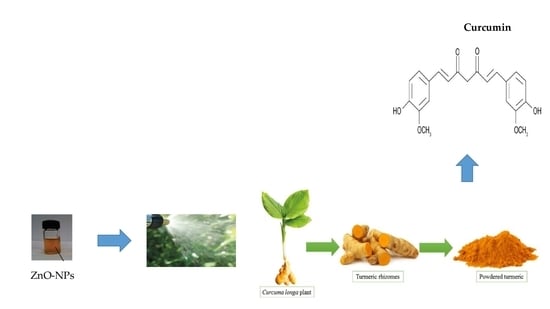Enhancement of the Bioactive Compound Content and Antibacterial Activities in Curcuma Longa Using Zinc Oxide Nanoparticles
Abstract
1. Introduction
2. Materials and Methods
2.1. Plant Materials and Extract Preparation
2.2. Determination of Curcumin, Bisdemethoxycurcumin, and Demethoxycurcumin Contents via High-Performance Liquid Chromatography (HPLC)
2.3. Determination of Nanozinc Curcumin Ethanolic Extract Antimicrobial Activity via Disc Diffusion Assay
2.3.1. Disc Diffusion Assay
2.3.2. Minimum Inhibitory Concentration Test (MIC)
2.3.3. Time–Kill Test of ZnO NPs
2.4. Statistical Analyses
3. Results
3.1. HPLC Results
3.2. Antibacterial Susceptibility
3.3. The Effect of Nanoparticles on the Antimicrobial Activity of Curcumin Ethanolic Extract
4. Discussion
5. Conclusions
Funding
Institutional Review Board Statement
Informed Consent Statement
Data Availability Statement
Acknowledgments
Conflicts of Interest
References
- Vijayakumar, M.D.; Surendhar, G.J.; Natrayan, L.; Patil, P.P.; Ram, P.M.; Paramasivam, P. Evolution and Recent Scenario of Nanotechnology in Agriculture and Food Industries. J. Nanomater. 2022, 2022, 1280411. [Google Scholar] [CrossRef]
- Fizan, M.; Fangyuan, Y.U.; Chen, C.; Ahmad, F.; Shamsul, H. Zinc Oxide Nanoparticles Help to Enhance Plant Growth and Alleviate Abiotic Stress: A Review. Curr. Protein Pept. Sci. 2021, 22, 362–375. [Google Scholar] [CrossRef] [PubMed]
- Yang, G.; Yuan, H.; Ji, H.; Liu, H.; Zhang, Y.; Wang, G.; Chen, L.; Guo, Z. Effect of ZnO nanoparticles on the productivity, Zn biofortification, and nutritional quality of rice in a life cycle study. Plant Physiol. Biochem. 2021, 163, 87–94. [Google Scholar] [CrossRef] [PubMed]
- Liu, L.; Nian, H.; Lian, T. Plants and rhizospheric environment: Affected by zinc oxide nanoparticles (ZnO NPs). A review. Plant Physiol. Biochem. 2022, 185, 91–100. [Google Scholar] [CrossRef]
- Azmat, A.; Tanveer, Y.; Yasmin, H.; Hassan, M.N.; Shahzad, A.; Reddy, M.; Ahmad, A. Coactive role of zinc oxide nanoparticles and plant growth promoting rhizobacteria for mitigation of synchronized effects of heat and drought stress in wheat plants. Chemosphere 2022, 297, 133982. [Google Scholar] [CrossRef]
- Wu, Q.; Fan, C.; Wang, H.; Han, Y.; Tai, F.; Wu, J.; Li, H.; He, R. Biphasic impacts of graphite-derived engineering carbon-based nanomaterials on plant performance: Effectiveness vs. nanotoxicity. Adv. Agrochem 2023, 2, 113–126. [Google Scholar] [CrossRef]
- Khan, F.; Shariq, M.; Asif, M.; Siddiqui, M.A.; Malan, P.; Ahmad, F. Green Nanotechnology: Plant-Mediated Nanoparticle Synthesis and Application. Nanomaterials 2022, 12, 673. [Google Scholar] [CrossRef]
- Šebesta, M.; Kolenčík, M.; Sunil, B.R.; Illa, R.; Mosnáček, J.; Ingle, A.P.; Urík, M. Field Application of ZnO and TiO2 Nanoparticles on Agricultural Plants. Agronomy 2021, 11, 2281. [Google Scholar] [CrossRef]
- Hosseinpour, A.; Haliloglu, K.; Tolga Cinisli, K.; Ozkan, G.; Ozturk, H.I.; Pour-Aboughadareh, A.; Poczai, P. Application of Zinc Oxide Nanoparticles and Plant Growth Promoting Bacteria Reduces Genetic Impairment under Salt Stress in Tomato (Solanum lycopersicum L. ‘Linda’). Agriculture 2022, 10, 521. [Google Scholar] [CrossRef]
- Kausar, A.; Hussain, S.; Javed, T.; Zafar, S.; Anwar, S.; Hussain, S.; Hussain, S.; Zahra, N.; Saqib, M. Zinc oxide nanoparticles as potential hallmarks for enhancing drought stress tolerance in wheat seedlings. Plant Physiol. Biochem. 2023, 195, 341–350. [Google Scholar]
- Doria-Manzur, A.; Sharifan, H.; Tejeda-Benitez, L. Application of zinc oxide nanoparticles to promote remediation of nickel by Sorghum bicolor: Metal ecotoxic potency and plant response. Int. J. Phytoremediation 2023, 25, 98–105. [Google Scholar] [CrossRef]
- Arya, P.R.; Abishad, P.; Unni, V.; Bibin, M.; Marita, D.; John, L.; Karthikeyan, A.; Nambiar, P.; Juliet, S.; Rawool, D.; et al. Antioxidant, Antibacterial and Antibiofilm Potential of Green Synthesized Silver-Zinc Oxide Nanocomposites from Curcuma longa extract against Multi-Drug Resistant Enteroaggregative E. coli. Med. Sci. Forum 2023, 21, 23. [Google Scholar]
- Yin, W.; Wang, Y.; Liu, L.; He, J. Biofilms: The microbial “protective clothing” in extreme environments. Int. J. Mol. Sci. 2019, 20, 3423. [Google Scholar] [CrossRef] [PubMed]
- Anita, P.; Sathyanarayana, H.P.; Kumar, K.; Ramanathan, K.; Kailasam, V. Antimicrobial efficacy of zinc oxide nanoparticle-coated aligners on Streptococcus mutans and Candida albicans. Am. J. Orthod. Dentofac. Orthop. 2023, 163, 338–346. [Google Scholar] [CrossRef]
- Alonso-Español, A.; Bravo, E.; Ribeiro-Vidal, H.; Virto, L.; Herrera, D.; Alonso, B.; Sanz, M. The Antimicrobial Activity of Curcumin and Xanthohumol on Bacterial Biofilms Developed over Dental Implant Surfaces. Int. J. Mol. Sci. 2023, 24, 2335. [Google Scholar] [CrossRef]
- Islam, F.; Shohag, S.; Uddin, M.J.; Islam, M.R.; Nafady, M.H.; Akter, A.; Mitra, S.; Roy, A.; Bin Emran, T.; Cavalu, S. Exploring the Journey of Zinc Oxide Nanoparticles (ZnO-NPs) toward Biomedical Applications. Materials 2022, 15, 2160. [Google Scholar] [CrossRef] [PubMed]
- Chattopadhyay, I.; Biswas, K.; Bandyopadhyay, U.; Banerjee, R.K. Turmeric and Curcumin: Biological Actions and Medicinal Applications. Curr. Sci. 2004, 87, 44–53. Available online: https://www.jstor.org/stable/24107978 (accessed on 24 November 2022).
- Sharma, N.; Gupta, N.; Orfali, R.; Kumar, V.; Patel, C.N.; Peng, J.; Perveen, S. Evaluation of the Antifungal, Antioxidant, and Anti-Diabetic Potential of the Essential Oil of Curcuma longa Leaves from the North-Western Himalayas by In Vitro and In Silico Analysis. Molecules 2022, 27, 7664. [Google Scholar] [CrossRef] [PubMed]
- Zhang, M.; Zhang, X.; Tian, T.; Zhang, Q.; Wen, Y.; Zhu, J.; Xiao, D.; Cui, W.; Lin, Y. Anti-inflammatory activity of curcumin-loaded tetrahedral framework nucleic acids on acute gouty arthritis. Bioact. Mater. 2022, 8, 368–380. [Google Scholar] [CrossRef]
- Guerrini, A.; Tacchini, M.; Chiocchio, I.; Grandini, A.; Radice, M.; Maresca, I.; Paganetto, G.; Sacchetti, G. A Comparative Study on Chemical Compositions and Biological Activities of Four Amazonian Ecuador Essential Oils: Curcuma longa L. (Zingiberaceae), Cymbopogon citratus (DC.) Stapf, (Poaceae), Ocimum campechianum Mill. (Lamiaceae), and Zingiber officinale Roscoe (Zingiberaceae). Antibiotics 2023, 12, 177. [Google Scholar] [CrossRef]
- Khattab, S.; Alkuwayti, M.A.; Yap, Y.-K.; Meligy, A.; Bani Ismail, M.; El Sherif, F. Foliar Spraying of ZnO Nanoparticals on Curcuma longa Had Increased Growth, Yield, Expression of Curcuminoid Synthesis Genes, and Curcuminoid Accumulation. Horticulturae 2023, 9, 355. [Google Scholar] [CrossRef]
- Jayaprakasha, G.K.; Jagan Mohan Rao, L.; Sakariah, K.K. Improved HPLC method for the determination of curcumin, demethoxycurcumin, and bisdemethoxycurcumin. J. Agric. Food Chem. 2002, 50, 3668–3672. [Google Scholar] [CrossRef]
- Rad, Z.M.; Nourafcan, H.; Mohebalipour, N.; Assadi, A.; Jamshidi, S. Effect of salicyllc acid foliar application on phytochemical composition, antioxidant and antimicrobial activity of Silybum marianum. Iraqi J. Agric. Sci. 2021, 52, 63–69. [Google Scholar] [CrossRef]
- Aldayel, M.; El Semary, N. UV irradiation-promoting effect on the antibacterial activity of cyanobacterial extracts against plant pathogens: A first record. Egypt. J. Biol. Pest Control. 2020, 30, 132. [Google Scholar] [CrossRef]
- Aldayel, M.F.; Alsobeg, M.S.; Khalifa, A. In vitro antibacterial activities of silver nanoparticles synthesised using the seed extracts of three varieties of Phoenix dactylifera. Braz. J. Biol. 2020, 82, 1–8. [Google Scholar] [CrossRef]
- Ellison, E.; Blaylock, A.D.; Sanchez, C.; Smith, R. Exploring controlled release nitrogen fertilizers for vegetable and melon crop production in California and Arizona. In Proceedings of the 2013 Western Nutrient Management Conference, Reno, NV, USA, 7–8 March 2013; Volume 10, pp. 17–22. [Google Scholar]
- Adil, M.; Bashir, S.; Bashir, S.; Aslam, Z.; Ahmad, N.; Younas, T.; Asghar, R.M.A.; Alkahtani, J.; Dwiningsih, Y.; Elshikh, M.S. Zinc oxide nanoparticles improved chlorophyll contents, physical parameters, and wheat yield under salt stress. Front. Plant Sci. 2022, 13, 932861. [Google Scholar] [CrossRef] [PubMed]
- Derosa, M.C.; Monreal, C.; Schnitzer, M.; Walsh, R.; Sultan, Y. Nanotechnology in fertilizers. Nat. Nanotechnol. 2010, 5, 91. [Google Scholar] [CrossRef]
- Kaskatepe, B.; Ozturk, S. Assessment of synergistic activity of rhamnolipid and linezolid against methicillin-resistant Staphylococcus aureus in-vitro and in-vivo with Galleria mellonella larvae model. Microb. Pathog. 2023, 174, 105945. [Google Scholar] [CrossRef] [PubMed]
- Adamczak, A.; Arowski, M.O.; Karpiński, T.M. Curcumin, a Natural Antimicrobial Agent with Strain-Specific Activity. Pharmaceuticals 2020, 13, 153. [Google Scholar] [CrossRef] [PubMed]
- Mirzahosseinipour, M.M.; Khorsandi, K.; Mehrgan, R.H.; Ghazaeian, M.; Shahidi, F.K. Antimicrobial photodynamic and wound healing activity of curcumin encapsulated in silica nanoparticles. Photodiagnosis Photodyn. Ther. 2020, 29, 101639. [Google Scholar] [CrossRef] [PubMed]
- Trigo-Gutierrez, J.K.; Vega-Chacón, Y.; Soares, A.B.; de Oliveira Mima, E.G. Antimicrobial Activity of Curcumin in Nanoformulations: A Comprehensive Review. Int. J. Mol. Sci. 2021, 22, 7130. [Google Scholar] [CrossRef] [PubMed]
- Zheng, D.; Huang, C.; Huang, H.; Zhao, Y.; Khan, M.R.U.; Zhao, H.; Huang, L. Antibacterial mechanism of curcumin: A review. Chem. Biodivers. 2020, 17, 2000171. [Google Scholar] [CrossRef] [PubMed]
- Joe, B.; Vijaykuma, M.; Lokesh, B. Biological properties of Curcumin-cellular and molecular mechanisms of action. Critical Reviews in Food Science and Nutrition. Crit. Rev. Food Sci. Nutr. 2004, 44, 97–111. [Google Scholar] [CrossRef]
- Kranjec, C.; Morales Angeles, D.; Torrissen Mårli, M.; Fernández, L.; García, P.; Kjos, M.; Diep, D.B. Staphylococcal Biofilms: Challenges and Novel Therapeutic Perspectives. Antibiotics 2021, 10, 131. [Google Scholar] [CrossRef] [PubMed]
- Rani, N.; Rani, S.; Patel, H.; Yadav, S.; Saini, M.; Rawat, S.; Saini, K. Characterization and investigation of antioxidant and antimicrobial activity of zinc oxide nanoparticles prepared using leaves extract of Nyctanthes arbor-tristis. Inorg. Chem. Commun. 2023, 150, 110516. [Google Scholar] [CrossRef]
- Nagajyothi, P.C.; Lee, S.-E.; An, M.; Lee, K.-D. Green synthesis of silver and gold nanoparticles using Lonicera Japonica flower extract. Bull. Korean Chem. Soc. 2012, 33, 2609–2612. [Google Scholar] [CrossRef]
- Nethradevi, C.; Sivakumar, P.; Renganathan, S. Green synthesis of silver nanoparticles using Datura metal flower extract and evaluation of their antimicrobial activity. Int. J. Nanomater. Biostruct. 2012, 2, 16–21. [Google Scholar]




| Test Solution | Inhibition Zone (mm) | ||||
|---|---|---|---|---|---|
| S. aureus | E. coli | Actinobacteria baumannii | Bacillus sp. | Pseudomonas aeruginosa | |
| Curcumin extract (control) | 3 ± 1 f * | 6 ± 2 b | 4 ± 2 | 5 ± 2 | 7 ± 2 f |
| Curcumin extract 5 mg/L | 12 ± 1 b | 5 ± 2 c | 8 ± 1 | 10 ± 3 | 13 ± 1 b |
| Curcumin extract 10 mg/L | 11 ± 1 c | 0 ± 0 | 13 ± 2 | 14 ± 1 | 9 ± 1 d |
| Curcumin extract 20 mg/L | 7 ± 2 e | 0 ± 0 | 10 ± 1 | 9 ± 2 | 8 ± 1 e |
| Curcumin extract 40 mg/L | 9 ± 1 d | 0 ± 0 | 8 ± 3 | 7 ± 2 | 10 ± 1 c |
| Imipenem 10 µg | 18 ± 3 a | 10 ± 2 a | 18 ± 2 | 17 ± 2 | 15 ± 2 a |
Disclaimer/Publisher’s Note: The statements, opinions and data contained in all publications are solely those of the individual author(s) and contributor(s) and not of MDPI and/or the editor(s). MDPI and/or the editor(s) disclaim responsibility for any injury to people or property resulting from any ideas, methods, instructions or products referred to in the content. |
© 2023 by the author. Licensee MDPI, Basel, Switzerland. This article is an open access article distributed under the terms and conditions of the Creative Commons Attribution (CC BY) license (https://creativecommons.org/licenses/by/4.0/).
Share and Cite
Aldayel, M.F. Enhancement of the Bioactive Compound Content and Antibacterial Activities in Curcuma Longa Using Zinc Oxide Nanoparticles. Molecules 2023, 28, 4935. https://doi.org/10.3390/molecules28134935
Aldayel MF. Enhancement of the Bioactive Compound Content and Antibacterial Activities in Curcuma Longa Using Zinc Oxide Nanoparticles. Molecules. 2023; 28(13):4935. https://doi.org/10.3390/molecules28134935
Chicago/Turabian StyleAldayel, Munirah F. 2023. "Enhancement of the Bioactive Compound Content and Antibacterial Activities in Curcuma Longa Using Zinc Oxide Nanoparticles" Molecules 28, no. 13: 4935. https://doi.org/10.3390/molecules28134935
APA StyleAldayel, M. F. (2023). Enhancement of the Bioactive Compound Content and Antibacterial Activities in Curcuma Longa Using Zinc Oxide Nanoparticles. Molecules, 28(13), 4935. https://doi.org/10.3390/molecules28134935







